In today’s world, personal safety has become a priority for many. Personal alarm keychains have emerged as one of the most accessible and easy-to-use safety devices, designed to draw attention in times of danger. At the push of a button or the pull of a pin, these compact devices emit a piercing sound, capable of deterring attackers and alerting passersby to a distress situation.
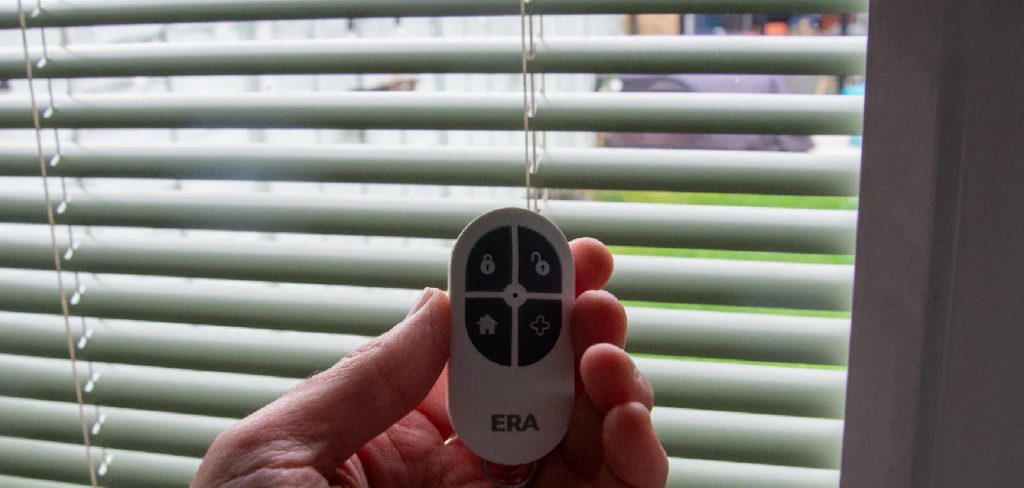
However, as much as it’s critical to know how to activate these alarms, understanding how to turn off personal alarm keychain is equally important. Whether it’s to halt an accidental activation or to silently deactivate the alarm in a situation that’s been resolved, knowing the right way to turn off your personal alarm keychain can prevent unnecessary panic and confusion.
This aspect of personal safety devices is often overlooked, underscoring why it’s crucial to familiarize oneself with the operational mechanics of these life-saving gadgets.
Types of Personal Alarm Keychains
Personal alarm keychains come in various forms, each designed to suit different preferences and safety needs. Understanding the types available is crucial for selecting the one that best fits your lifestyle and safety concerns.
A. Basic Sound Alarm Keychains
The most fundamental type is the basic sound alarm keychain, which focuses purely on producing a loud, attention-grabbing noise when activated. These devices are typically small, lightweight, and easy to carry, making them a staple in personal safety arsenals.
The simplicity of their design—often featuring a button press or pull-pin mechanism—allows for quick and straightforward operation in emergencies.
B. LED Flashlight Alarm Keychains

Adding an extra layer of functionality, LED flashlight alarm keychains not only serve as audible alert systems but also provide light. This dual purpose makes them exceptionally useful for individuals who often find themselves walking in poorly lit environments.
The inclusion of an LED flashlight aids in navigation and can help deter potential attackers by illuminating their presence, all while retaining the ability to emit a loud alarm when necessary.
C. Combination Alarm and Self-Defense Keychains
For those seeking comprehensive safety tools, combination alarms, and self-defense keychains is the perfect solution. These multipurpose devices incorporate features such as sound alarms, LED flashlights, and sometimes even pepper spray or pointed edges designed for self-defense.
Such keychains are geared towards individuals who prioritize a full range of protective measures and value the convenience of having several safety options in a single, compact device.
Reasons for Turning Off a Personal Alarm
There are several key reasons why someone might need to know how to turn off a personal alarm keychain. These can range from accidental triggers to deliberate tests of the device’s functionality and the need for discretion in specific scenarios.
A. Accidental Activation
Accident activation is one of the most common reasons for needing to turn off a personal alarm keychain. Given the portable nature of these devices, it’s easy for them to be inadvertently triggered inside a bag, pocket, or during handling.
Such unintentional alarms can cause unnecessary stress and confusion to both the user and surrounding people, making it essential to quickly and efficiently deactivate the device.
B. Testing the Alarm Functionality
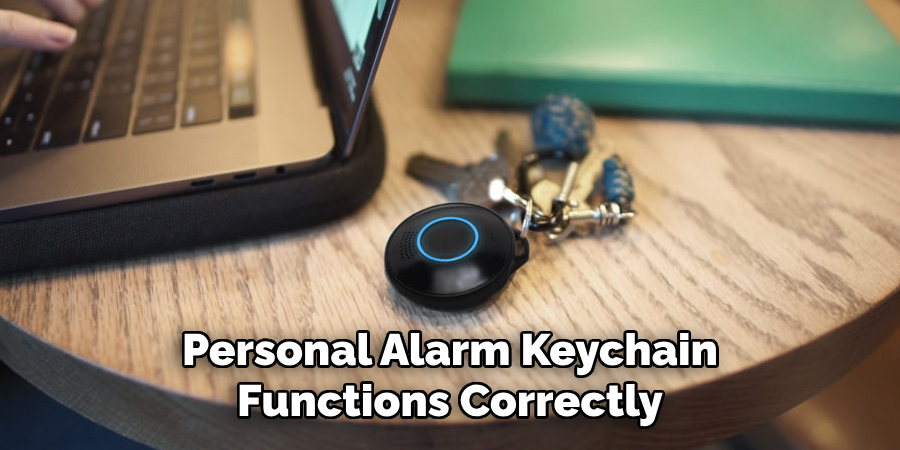
Regular testing is crucial to ensure that a personal alarm keychain functions correctly in a real emergency. Users might deliberately activate the alarm to check its sound level, battery life, and overall operability.
After such tests, knowing how to promptly silence the alarm is important, as it prevents prolonged noise that could disturb others and ensures the device is ready for future use.
C. Discreet Use in Emergency Situations
In certain dangerous situations, drawing attention might not be the immediate solution; instead, discretion is required. For instance, if an individual finds themselves in close proximity to a threat, silently deactivating the alarm could prevent escalation and buy crucial time to seek help or exit the situation safely.
Understanding how to turn off the personal alarm keychain quickly and quietly becomes an invaluable aspect of managing these delicate circumstances effectively.
Safety Precautions
Ensuring the safe use and storage of personal alarm keychains is critical to prevent accidental activations and maintain their effectiveness in real emergencies.
Handling these devices with care is paramount; it minimizes the likelihood of unintended triggers that can lead to panic or desensitize others to the alarm sound, potentially undermining its intended purpose as a safety tool. Users should familiarize themselves with the mechanism of their specific model—whether it involves a button press, pull pin, or another method—to avoid accidental activation.
Storing the keychain in a secure but easily accessible spot is equally important. Ideally, it should be placed in an area that is both safe from unnecessary contact that could trigger the alarm and readily available in case of an emergency. For instance, attaching it to a keyring that is carried regularly or to an outer compartment of a bag can strike this balance effectively.

Additionally, regular maintenance, such as checking the battery life and testing the alarm function in a controlled environment, ensures the device remains reliable. Adhering to these guidelines not only extends the lifespan of the personal alarm keychain but also maximizes its utility as a personal safety device.
Identifying the Activation Mechanism
Understanding the activation mechanism of a personal alarm keychain is essential for efficient and effective use, especially in emergency situations. There are generally three common types of activation mechanisms found in personal safety alarms.
A. Button-Based Activation

Button-based activation is one of the simplest and most intuitive mechanisms. It typically involves pressing a button—sometimes needing a firm press or held down for a few seconds to prevent accidental activation.
This type of mechanism is user-friendly and allows for quick activation, but users must remember the specific button, among others, especially in high-stress situations.
B. Pull-Pin Activation
Pull-pin activation requires the user to pull a pin or ring connected to the keychain to activate the alarm. This design is engineered to prevent accidental activation, as it requires deliberate action.
However, in emergencies, it can be slightly more challenging to use, particularly if the user has limited dexterity or is under duress. Re-inserting the pin deactivates the alarm.
C. Twist or Slide Activation
Some personal alarms are activated by a twisting motion or by sliding a switch. These mechanisms can be advantageous for preventing accidental alarms and offering a discreet activation option.
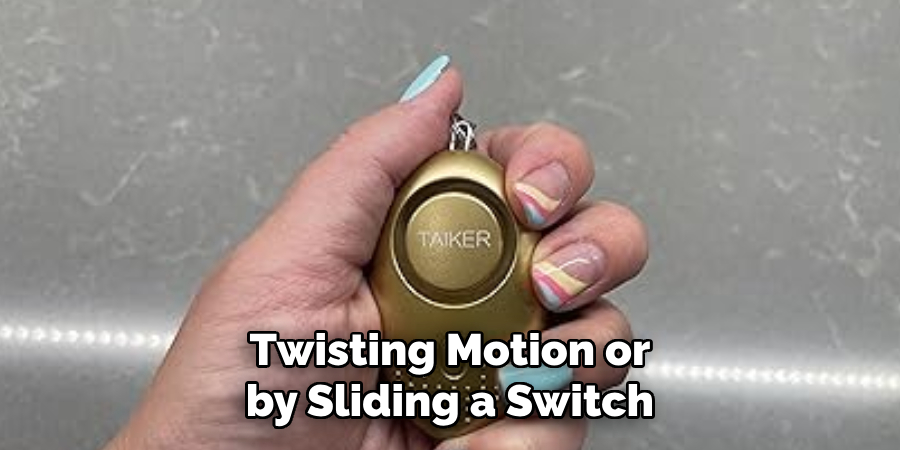
However, they may require both hands to operate or more precise motor skills, which could be a drawback in a tense situation where quick and easy activation is needed. Users should practice these mechanisms to ensure they can operate their devices smoothly when it counts.
How to Turn Off Personal Alarm Keychain: Disabling the Alarm
Successfully deactivating a personal alarm keychain is just as crucial as knowing how to activate it. Based on its activation mechanism, each type of alarm has a specific method for being turned off. Understanding these methods ensures that users can efficiently silence their alarms when necessary without causing undue stress or noise.
A. Button-Based Alarms: Holding the Button
For button-based alarms, deactivation usually requires the user to press and hold the activation button for a few seconds. This design intends to prevent the alarm from being turned off accidentally during an emergency.
Users need to familiarize themselves with the feel of the button and the required pressure and duration needed to deactivate the alarm, making it easier to perform this action under stress.
B. Pull-Pin Alarms: Reinserting the Pin
Deactivating a pull-pin alarm is straightforward but requires the user to keep the pin secure and accessible. To turn off the alarm, the pin must be reinserted into the device exactly where it was removed from.
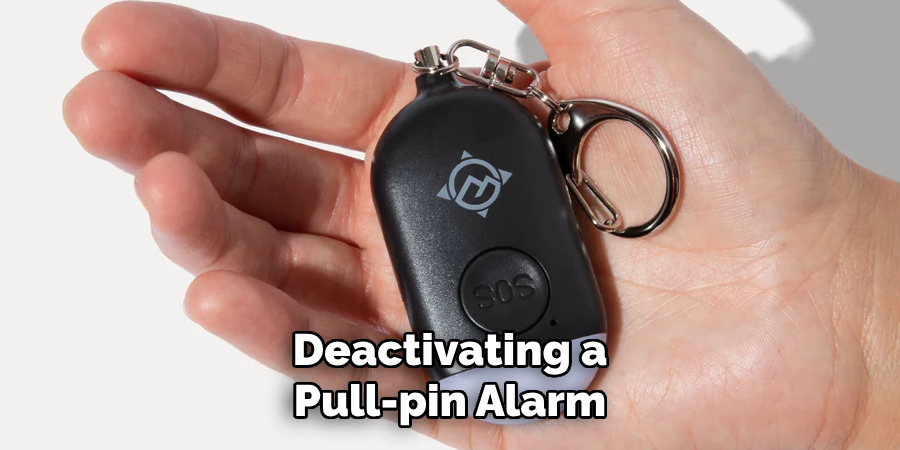
This action should be practiced regularly to ensure smooth execution in potentially high-stress scenarios. Losing the pin can render the alarm continuously active, so some models may offer a secondary deactivation method, or users might need to seek a replacement pin from the manufacturer.
C. Twist or Slide Alarms: Returning to Off Position
Twist or slide alarms are disabled by simply reversing the activation motion—twisting or sliding the mechanism back to its original position. Although this may sound simple, in a tense situation, precision can be compromised, making familiarity with the device’s feel and operation essential.
Like the other mechanisms, practicing this action can significantly improve the user’s ability to deactivate the alarm swiftly and efficiently when needed, minimizing unnecessary stress and disturbance.
How to Turn Off Personal Alarm Keychain: Discreet Deactivation Techniques
In scenarios where drawing additional attention might exacerbate a situation, knowing how to discreetly deactivate a personal alarm keychain is essential. Here are some tips for silencing these devices without drawing undue attention:
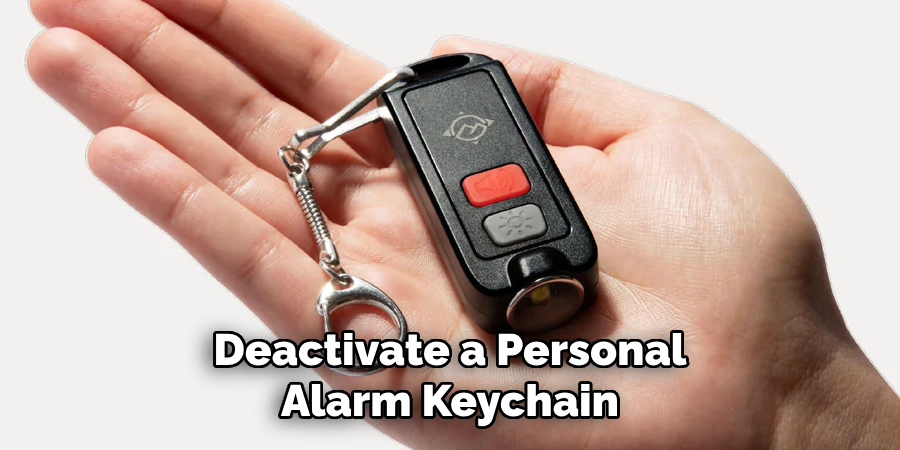
- Preparation is Key: Familiarize yourself deeply with your device’s deactivation process in a calm, controlled setting. This muscle memory can help in situations where discretion is necessary, allowing for quick and quiet deactivation.
- Maintain a Firm Grip: When deactivating your alarm, especially pull-pin models, hold the alarm and pin firmly to muffle any noise that reinserting the pin might produce.
- Cover the Speaker: If the situation allows, lightly covering the alarm speaker with your hand or a piece of cloth can significantly reduce the emitted sound as you work to deactivate it. This technique should be practiced beforehand to ensure it doesn’t impede your ability to turn off the alarm.
- Use Diversion: When some noise is unavoidable, create a diversion or wait for a louder ambient noise to cover the deactivation sound. This could be as simple as timing the deactivation with a loud passing vehicle or amidst a crowd’s noise.
- Remain Calm: Your ability to act discreetly under pressure hinges significantly on your state of mind. Taking a deep breath and focusing can reduce fumbling and ensure a swift, quiet deactivation.
By incorporating these strategies, users can ensure they can subtly deactivate their personal alarm keychain, maintaining their safety without escalating the situation.
Regular Maintenance
Ensuring your personal safety alarm keychain remains effective and reliable over time requires consistent maintenance. Detailed below are three critical aspects of maintaining your device:
A. Testing the Alarm Functionality Periodically
It’s essential to periodically test your safety alarm to ensure it’s in working order. You can do this by activating the alarm in a controlled environment every few months.
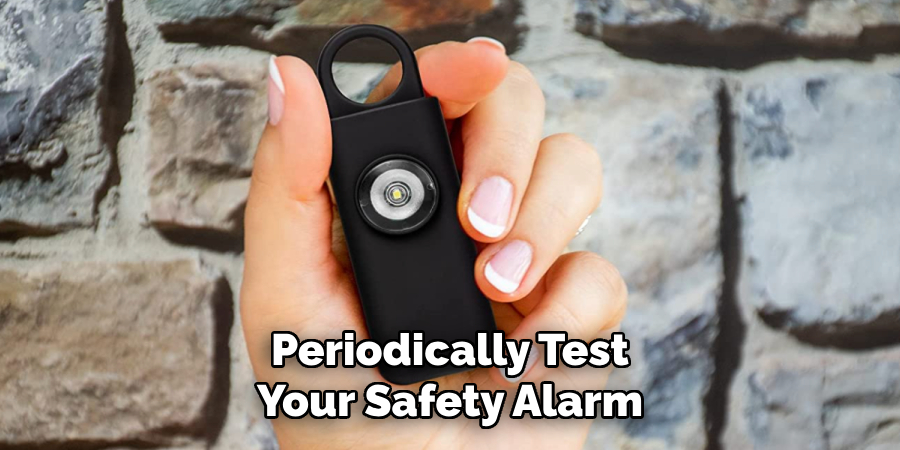
Pay attention to the loudness of the alarm and the ease of activation and deactivation. This regular testing helps identify any potential issues before they become problematic in an emergency situation.
B. Cleaning and Inspecting for Wear and Tear
Your personal alarm is likely to experience wear and tear, especially if it’s carried daily. Inspect your device regularly for any signs of damage, such as cracks or loose components, that could affect its functionality.
Clean your alarm with a dry or slightly damp cloth to remove any dust or debris that may have accumulated, ensuring the speaker vents are clear for maximum sound emission.
C. Ensuring Battery Health
The battery is the lifeblood of your personal safety alarm. Always use the manufacturer’s recommended battery type and routinely check the battery level or strength. Many devices feature a low battery indicator, but for those that don’t, consider scheduling battery replacements or recharges every 6 to 12 months, even if the alarm has not been used frequently.
This proactive approach guarantees your alarm will have the power it needs when it matters most.
Personal Safety Tips
Ensuring your safety is not just about having a personal alarm— it’s also about how you use it. Below are some crucial tips for maximizing your safety through the effective use of your personal safety alarm keychain.
A. Carrying the Alarm in Easily Accessible Locations
Always carry your personal alarm in a location where it can be easily and quickly accessed. This could mean attaching it to a belt loop, the strap of a bag, or anywhere within immediate reach. Avoid keeping it in places where you have to search for it, such as the bottom of a bag.
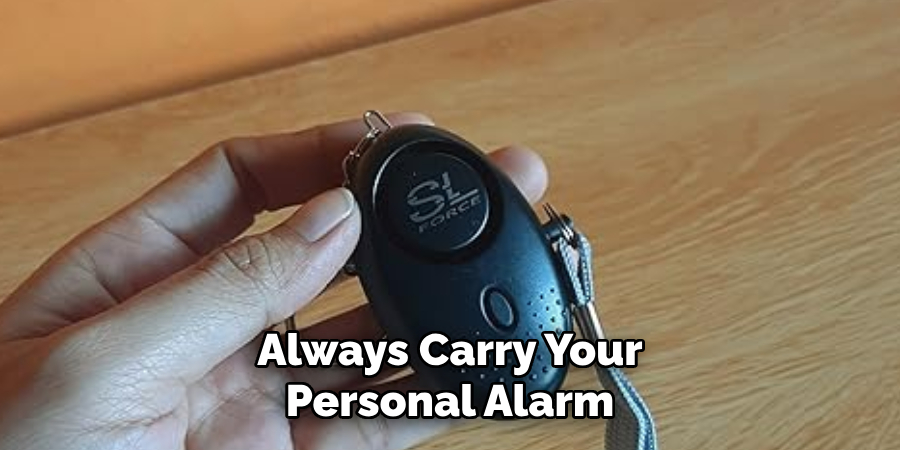
The goal is to ensure you can grab and activate the alarm without looking or having to think, especially in situations where seconds count.
B. Using the Alarm as a Deterrent in Unsafe Situations
Your personal safety alarm is not just a tool for alerting others in an emergency; it can also act as a powerful deterrent to potential attackers. In situations where you feel threatened or unsafe, holding your alarm in a visible manner and demonstrating your readiness to activate it can discourage unwelcome approaches.
The mere presence of the alarm signifies that you are not an easy target, and any attempt at aggression could have immediate consequences.
C. Seeking Professional Assistance for Malfunctions
Should you encounter any malfunctions or issues with your personal safety alarm, it’s crucial to seek professional assistance rather than attempting a DIY repair. Contact the manufacturer or a professional technician to address any problems.
Tampering with the device yourself could lead to further damage or voiding any warranties. Furthermore, professional servicing ensures your alarm remains in optimal condition, ready to protect you when needed.
Alternatives to Turning Off
In some scenarios, completely deactivating your personal safety alarm may not be the most advantageous course of action. Instead, several alternative methods can be employed to de-escalate a situation without entirely silencing the alarm. These approaches rely on using the alarm’s presence and potential activation as a deterrent or negotiating tool.
A. Partial Activation
Partially activating the alarm so it emits a brief sound can serve as a warning signal to potential aggressors, showing that you are prepared to use it. This method can be particularly effective in deterring someone without escalating the situation to full alarm activation, which might draw widespread attention.
B. Visible Display
Simply displaying the alarm prominently can act as a deterrent. Holding it in your hand in a visible manner signals to potential threats that you are aware, prepared, and capable of drawing immediate attention to any aggressive behavior they might display.
C. Verbal Warnings
Coupling the visible display or partial activation of your alarm with a firm, confident verbal warning can further enhance its deterrent effect. Clearly stating your intention to activate the alarm if the individual does not withdraw can be a powerful de-escalation technique.
By considering these alternatives, individuals can leverage the multifaceted utility of their personal safety alarm keychain not only as a means of raising an alarm but also as a versatile tool for managing and de-escalating potentially unsafe situations.
Final Thoughts
In the realm of personal safety and emergency preparedness, the personal alarm keychain emerges as a crucial tool, bridging the gap between vulnerability and empowerment. These devices not only serve as a deterrent to potential threats but also provide a lifeline by signaling for help when it’s most needed.
Understanding how to turn off personal alarm keychain, along with its effective usage and maintenance, are instrumental skills that enhance your safety protocol. Individuals must familiarize themselves with the operational nuances of their alarms—practicing activation, deactivation, and maintenance—to ensure that the alarm functions as an extension of their safety measures rather than a mere accessory in moments of distress.
By integrating these practices into your personal security routine, you significantly improve your resilience against unforeseen dangers. Encouraging proactive engagement with and understanding of your personal safety alarm keychain paves the way for a more secure and confident stance against threats in everyday life.
About
Safety Fic is a distinguished figure in the world of Diy design, with a decade of expertise creating innovative and sustainable Diy solutions. His professional focus lies in merging traditional craftsmanship with modern manufacturing techniques, fostering designs that are both practical and environmentally conscious. As the author of diy, Safety Fic delves into the art and science of Safety Fic-making, inspiring artisans and industry professionals alike.
Education RMIT University
(Melbourne, Australia) Associate Degree in Design (Safety Fic) Focus on sustainable design, industry-driven projects, and practical craftsmanship. Gained hands-on experience with traditional and digital manufacturing tools, such as CAD and CNC software.
Nottingham Trent University
(United Kingdom) Bachelor’s in diyfastly.com and Product Design (Honors) Specialized in product design with a focus on blending creativity with production techniques. Participated in industry projects, working with companies like John Lewis and Vitsoe to gain real-world insights.
Publications and Impact
In diy, Safety Fic his insights on indoor design processes, materials, and strategies for efficient production. His writing bridges the gap between artisan knowledge and modern industry needs, making it a must-read for both budding designers and seasoned professionals.
